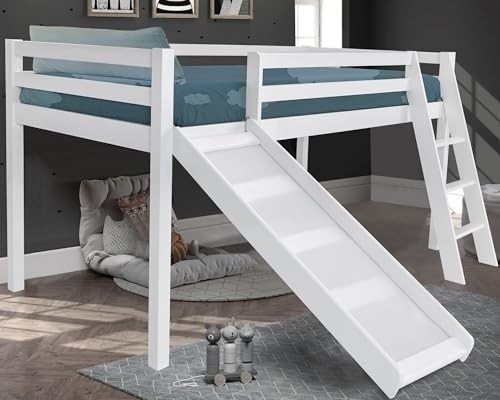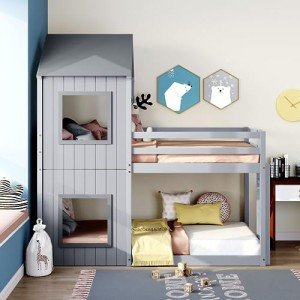
Bunk Beds For Teens
SigaVisión general
-
Fecha de fundación 22 de octubre de 1958
-
Sectores Software ( TIC / SaaS / Apps
-
Puestos de trabajo 0
-
Visitado 63
Descripción de la empresa
The 10 Most Scariest Things About UK Bunk Beds
Understanding UK Bunk Beds: A Comprehensive Guide
Bunk beds have ended up being a popular choice for many families across the United Kingdom. They offer a reliable option for saving space, accommodating several sleepers, and adding an element of fun to a child’s room. With various styles, products, and safety functions readily available, selecting the best bunk bed can be daunting. This post intends to offer a thorough look into UK bunk beds, covering their types, advantages, security standards, and buying suggestions.
The Types of Bunk Beds
When it pertains to bunk beds, the choices are practically endless. The main categories include:
1. Standard Bunk Beds
These are the traditional design, featuring two beds stacked one on top of the other. Basic bunk beds are perfect for brother or sisters sharing a room or slumber parties.
2. Loft Beds
Loft beds are raised beds without a lower bunk. This style uses ample space below for a study area, additional storage, or play space for kids.
3. L-Shaped Bunk Beds
These beds have an L-shape style, enabling them to suit corners or odd spaces in a space. They are often ideal for larger spaces and use versatility in sleeping plans.
4. Triple Bunk Beds
Created for larger households, triple bunk beds accommodate three sleeping areas. These beds offer vertical sleeping arrangements and can be an exceptional option for taking full advantage of space capacity.
5. Futon Bunk Beds
These flexible beds integrate a basic upper bunk with a futon or couch below. This style can be used for sleeping or seating, making it a multifunctional option for smaller areas.
6. Bunk Beds with Storage
Some contemporary bunk beds come geared up with drawers or shelving, offering additional storage space for clothing, toys, or books. This feature is especially advantageous in rooms that require organized storage services.
Advantages of Bunk Beds
Bunk beds provide numerous benefits, making them a preferable choice for numerous households:
-
Space-Saving: Bunk beds use vertical space, permitting more open flooring location in smaller sized rooms.
-
Price: Sharing a room and buying one bunk bed can be more affordable than purchasing different beds for multiple children.
-
Enjoyable Factor: Bunk beds supply a sense of experience and excitement, particularly for children, making bedtime more satisfying.
-
Versatile Layouts: With numerous styles readily available, bunk beds can fit any room design, ensuring design and functionality.
-
Storage Options: Many designs incorporate extra storage options, helping to keep rooms neat.
| Advantages of Bunk Beds | Description |
|---|---|
| Space-Saving | Utilizes vertical space to maximize flooring area. |
| Cost | More cost-efficient for families with multiple children. |
| Enjoyable Factor | Includes enjoyment to bedtime and promotes creative play. |
| Versatile Layouts | Mixes can fit different space configurations. |
| Storage Options | Built-in drawers and shelves assist keep products organized. |
Security Standards
When picking bunk beds, security must be a leading priority, especially for children. The UK has actually established guidelines to make sure that bunk beds fulfill particular safety standards. For instance:
-
Guardrails: Beds should have guardrails on both sides of the leading bunk to avoid unintentional falls.
-
Bed mattress Size: Beds need to be suitable with an appropriate bed mattress size to make sure safe use. The bed mattress must not surpass the top of the guardrails.

-
Tough Construction: Bunk beds need to be made from durable products to stand up to routine use, ensuring stability and longevity.
-
Weight Limit: Every bunk bed has a weight limit which should be stuck to for security factors.
-
Assembly Instructions: Proper assembly is crucial; follow the maker’s standards closely to guarantee structural integrity.
Purchasing Tips
When set to purchase a bunk bed, consider the following points:
-
Room Size: Measure the space dimensions to guarantee the chosen bed fits easily.
-
Height Consideration: Ensure there suffices room above the top bunk to avoid bumps on the ceiling.
-
Material Choice: Look for sturdy products with a quality finish. Wood and metal are popular options, with each providing different visual appeals and sturdiness.
-
Security Features: Verify that the bed meets safety specifications and has appropriate guardrails and a sturdy ladder.
-
Design Compatibility: Select a design that matches the existing design of the space.
-
Budget plan: Set a spending plan before exploring your options, as bunk beds can span a broad price range.
Often Asked Questions (FAQs)
1. What age is appropriate for a top bunk?
Typically, kids aged six and older can sleep on the leading bunk, however always check specific maker guidelines for age recommendations.
2. How do I maintain my bunk bed?
Regularly inspect for any loose screws or parts, tidy the bed periodically, and guarantee it stays stable.
3. Can bunk beds accommodate adults?
While some bunk beds are designed for heavier weights, the bulk are mostly meant for children. Inspect the weight restricts if thinking about adult use.

4. Are bunk beds simple to put together?
Most bunk beds include comprehensive assembly directions and all needed tools. Nevertheless, some designs might need professional assembly.
5. Can I use a thicker bed mattress on a bunk bed?
It is important to follow the producer’s standards relating to bed mattress thickness to make sure security and compliance with the guardrails.
Bunk beds are a flexible and practical option for households wanting to make the most of space and develop an enjoyable sleeping environment for their kids. With a myriad of styles available, it’s essential to consider the specific requirements of the home while focusing on safety and convenience. By comprehending the different types, benefits, and crucial factors to consider surrounding bunk beds, parents can make informed decisions that will improve their kids’s living areas.
